Much of Pew Research Center’s past research on the state of journalism in the United States has focused on Americans’ assessments of how well journalists are doing their jobs and serving the public. In this new survey, researchers got the other side of the story – asking journalists to provide their own sense of how well they are doing and how the public receives their work.
Overall, journalists give themselves relatively high marks on performing several of the core functions of journalism. The public, however, does not see it the same way.
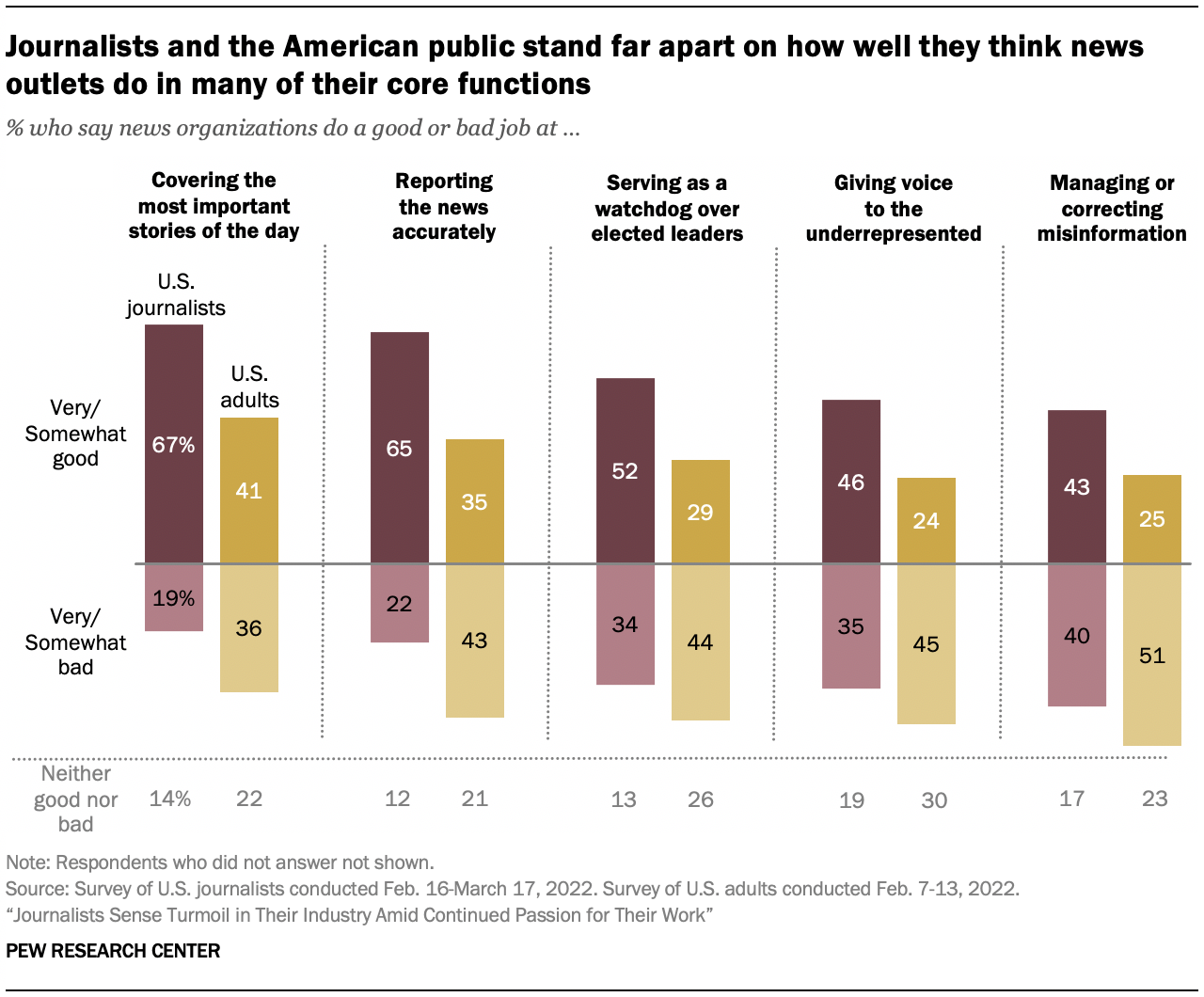
The survey asked about five core functions of news organizations, and journalists gave more positive than negative assessments for four of them. Around two-thirds of journalists surveyed say news organizations do a very or somewhat good job covering the most important stories of the day (67%) and reporting news accurately (65%). By comparison, roughly one-in-five journalists say news outlets do a very or somewhat bad job at these core functions, while 14% and 12%, respectively, say they do a neither good nor bad job.
About half of the journalists surveyed say news organizations do at least somewhat well at serving as watchdogs over elected leaders (52%) and giving voice to the underrepresented (46%), versus roughly a third who say they do a bad job at each of these tasks (34% and 35%, respectively). But journalists’ assessments are about as negative as they are positive when it comes to the job the news media does managing or correcting misinformation: 43% say news organizations do a very or somewhat good job at this, while 40% say they do poorly.
The American public, however, delivers a decidedly more negative assessment than journalists do for all five of the core functions. In a separate representative survey of 9,388 U.S. adults conducted Feb. 7-13, about twice as many adults say news organizations do a very or somewhat bad job at managing or correcting misinformation (51%) as say they do a good job (25%). And about a third of Americans or fewer say news organizations do at least a somewhat good job giving voice to the underrepresented (24%), serving as a watchdog over elected leaders (29%) and reporting the news accurately (35%), compared with larger shares who say journalists do a bad job in all these areas.
One core function that Americans are slightly more likely to say that news organizations do a good job than bad job is at covering the most important stories of the day – 41% say they do a good job and 36% say they do badly. That is still well below the 67% of journalists who say they do a good job of covering the most important stories.
Journalists sense that Americans don’t have high trust in the news media overall, but think their own audience trusts them
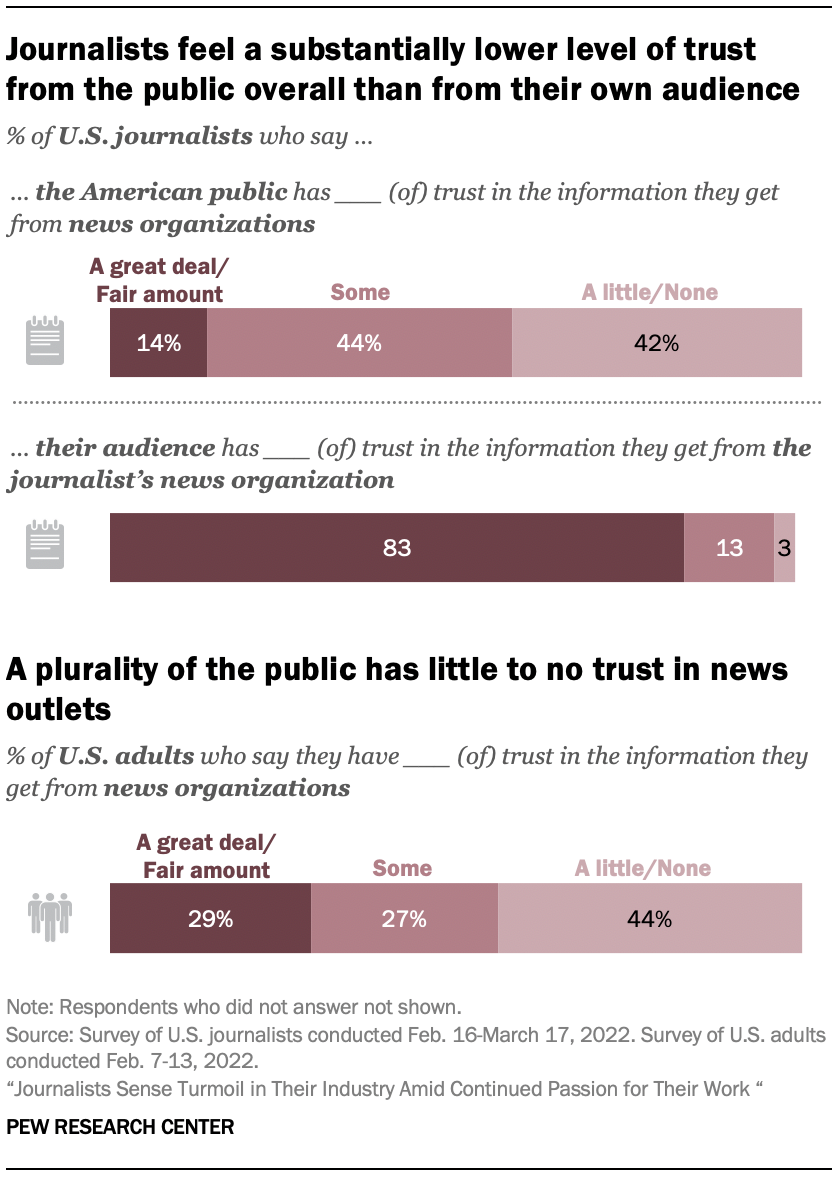
Relatively few Americans have a high level of trust in news outlets – and journalists sense that. About four-in-ten journalists (42%) say they think the public as a whole has little or no trust in the information they get from news organizations, and a similar share (44%) say they think the public has some trust. Only 14% of the journalists surveyed say they think the public generally has a great deal or even a fair amount of trust in the news. Given those views, it makes sense that about half of journalists (52%) say it is not possible to report news that nearly everyone finds accurate (see Chapter 5).
At the same time, journalists are far more confident that their audience trusts the news organization they work for (or the main one they work for if they work for more than one). Fully 83% of journalists think their audience has at least a fair amount of trust in the information they get from their news organization, including 35% who say their audience has a great deal of trust. Another 13% say their audience has some trust, while just 3% say their audience has “a little” or no trust at all.
The question to the public was a little different. The February 2022 survey of U.S. adults asked about the level of trust they have in the information they get from news organizations. About three-in-ten adults overall (29%) say they have a great deal or fair amount of trust in this information, and 27% say they have some trust. A plurality (44%) say they have “a little” or no trust.
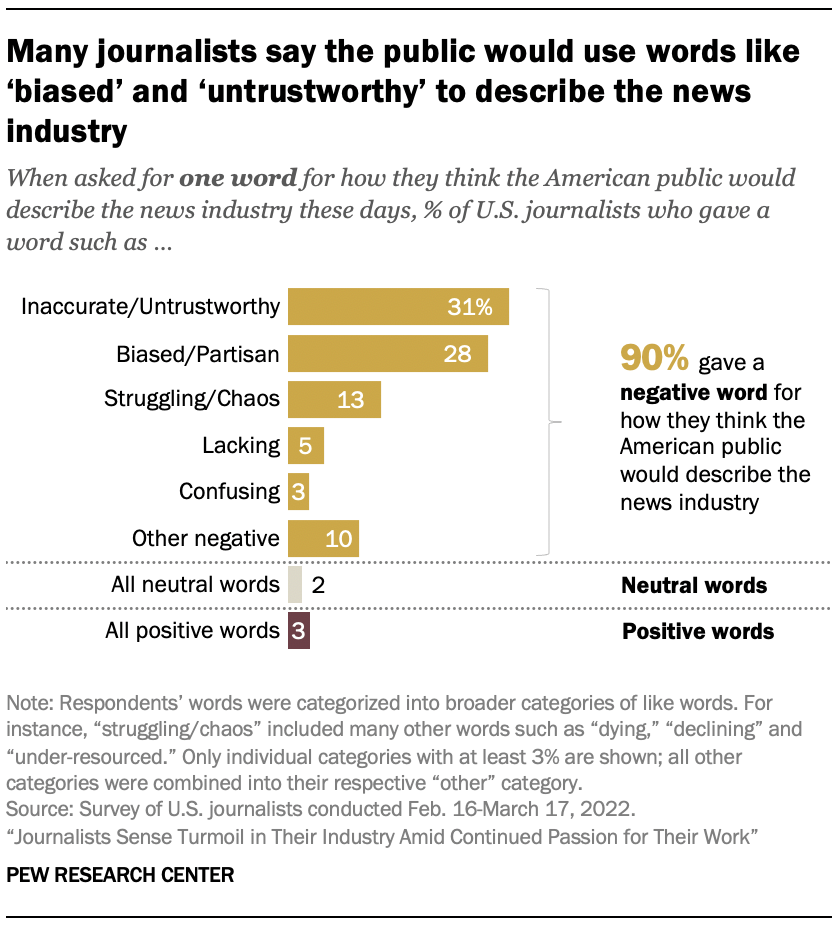
Journalists’ negative sense of how the public views journalism in general comes through even more strongly in the one word they think the public would use to describe the news industry today.1 Overall, nine-in-ten responses provided a negative word. Just 3% suggested the public would use a positive word (such as “important”), while 2% were neutral in tenor.
Two concepts alone accounted for about six-in-ten responses: 31% of journalists think the public’s views of the news media are summed up with words like “inaccurate” or “untrustworthy,” while 28% offered words such as “biased,” “partisan” or “divisive.”
See Chapter 1 for how journalists would use one word to describe their own view of the industry today.
Many journalists feel connected to their audiences; the public doesn’t feel the same level of connection
Another disconnect between the public and journalists is how connected each group feels to the other. Among journalists, close to half (46%) say they feel extremely or very connected to their audience, while another 37% say they feel somewhat connected. Far fewer – 16% – say they feel little or no connection.
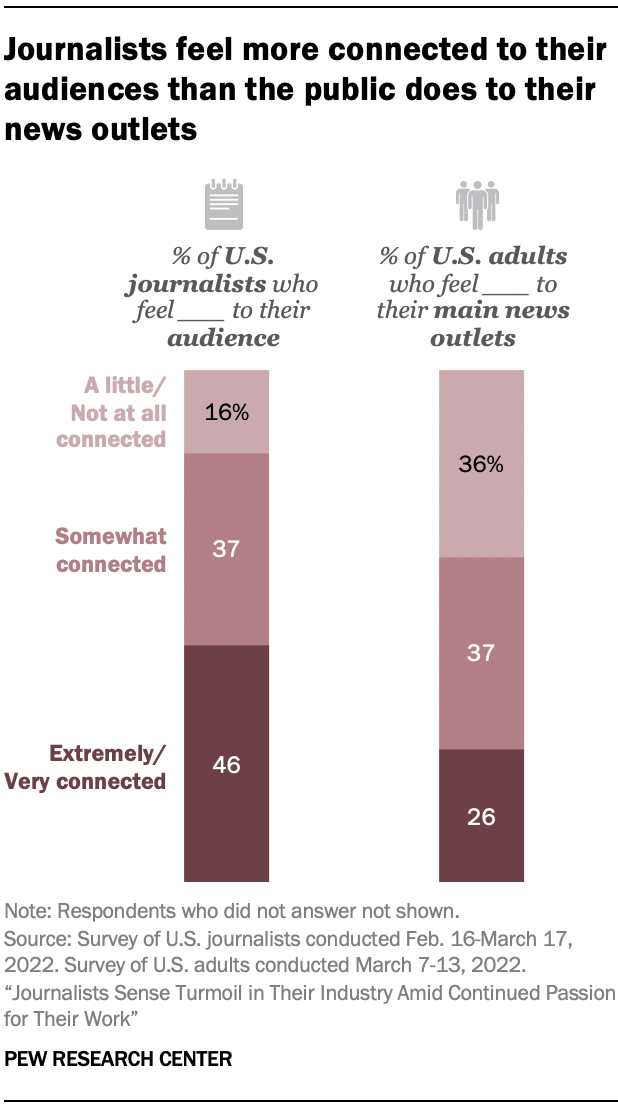
Tied to this, nearly four-in-ten journalists surveyed (38%) say they interact with the public about their own work or the work of their organization one or more times a day, and an additional 21% do so several times a week. Among those who do interact with the public, the vast majority (83%) say these interactions are helpful.
The public feels considerably less connected to their news sources than journalists do with their audiences. In another representative survey of 10,441 U.S. adults conducted March 7-13, about a quarter of Americans (26%) say they are extremely or very connected to their main news organizations, far lower than the 46% of journalists who feel extremely or very connected to their audiences. Another 37% of Americans say they feel somewhat connected to their main news sources, while 36% feel little to no connection.
Previous Center research has found that a slim majority of Americans feel it is important to be connected to the outlets where they get their news, and that those who feel more connected tend to feel more positively toward the news media.
Journalists express confidence in their sources but rarely interview them in person
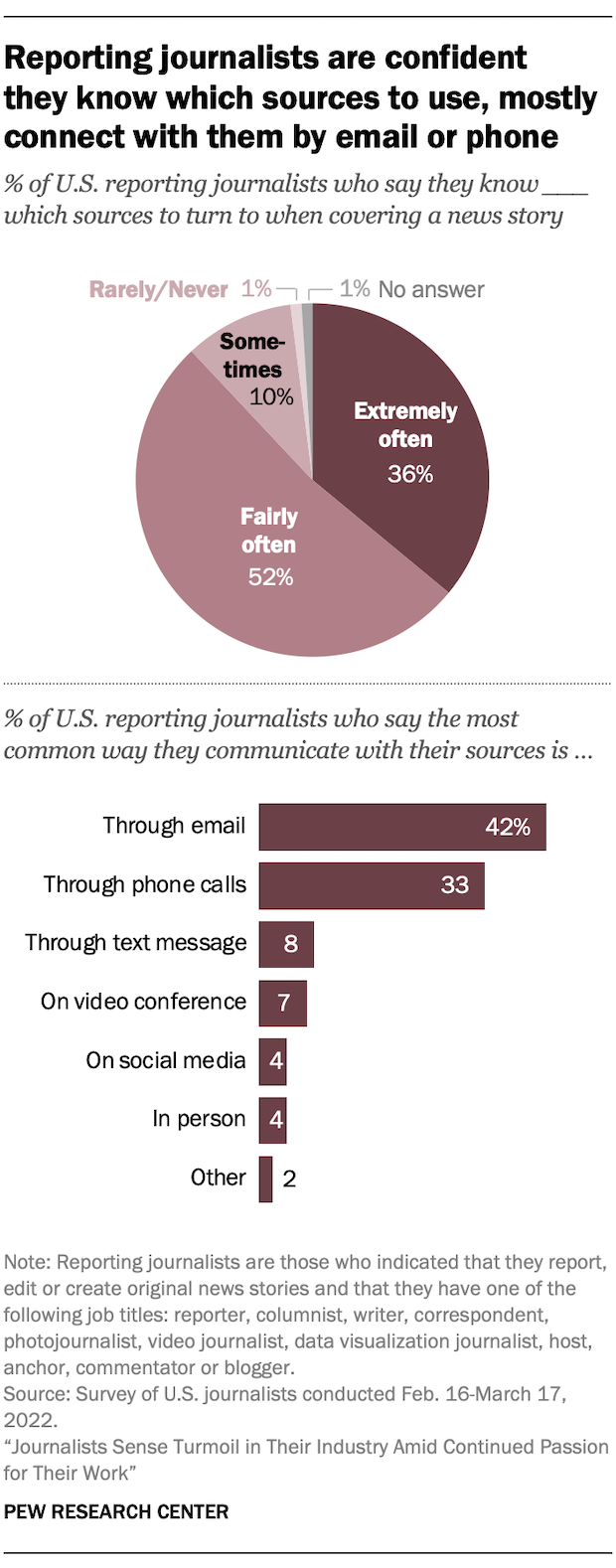
One reporting element that the public may deem important is the mix of sources journalists use in their stories. In an earlier study, for example, about half of U.S. adults say that when deciding which outlets to get their news from, it is at least somewhat important that news stories cover people like them.
Overall, reporting journalists feel quite confident that they know which sources to turn to when covering a story. (Reporting journalists are those who indicated in the survey that they report, edit or create original news stories and that they have one of the following job titles: reporter, columnist, writer, correspondent, photojournalist, video journalist, data visualization journalist, host, anchor, commentator or blogger. About three-quarters of all journalists in this study – 76% – are reporting journalists.)
Roughly a third (36%) of reporting journalists say they know which sources to turn to extremely often, and another 52% say they feel this way fairly often. Whether related to the pandemic or a reflection of technology and deadline pressures, few conversations with sources happen in person today. Only 4% of reporting journalists say they mainly communicate with sources in person; the largest share say they connect with sources mostly through email (42%), and a third mostly rely on phone calls (33%). Text messages (8%), video conferences (7%) and social media (4%) are the primary ways other reporting journalists connect with sources.




